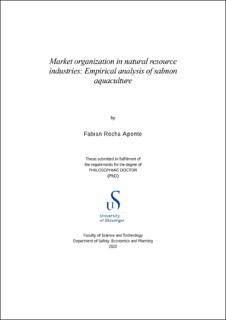| dc.contributor.advisor | Landazuri-Tveterås, Sigbjørn | |
| dc.contributor.author | Rocha Aponte, Fabian | |
| dc.date.accessioned | 2020-05-25T13:48:59Z | |
| dc.date.available | 2020-05-25T13:48:59Z | |
| dc.date.issued | 2020-05 | |
| dc.identifier.citation | Market organization in natural resource industries: Empirical analysis of salmon aquaculture by Fabian Rocha Aponte, Stavanger : University of Stavanger, 2020 (PhD thesis UiS, no. 514) | en_US |
| dc.identifier.isbn | 978-82-7644-921-1 | |
| dc.identifier.issn | 1890-1387 | |
| dc.identifier.uri | https://hdl.handle.net/11250/2655504 | |
| dc.description | PhD thesis in Risk management and societal safety | en_US |
| dc.description.abstract | This thesis aims to contribute to a better understanding of the intricacies of market organization in a renewable natural resource industry: The Norwegian salmon industry. Natural resource industries are of special interest because they depend on the interactions between environmental/biological conditions, firms, and institutions (Van Der Ploeg & Poelhekke, 2017; Van der Ploeg & Venables, 2011). In particular, due to the public interest in managing natural resources, industries that rely on them face heavy regulations everywhere; often, the effects of these regulations on natural resources and their related industries may determine if the possession of such resources is a blessing or a curse (Arezki & van der Ploeg, 2007; Van der Ploeg, 2011).
The Norwegian salmon aquaculture sector serves as a useful case in market organization for four main reasons: 1) the sector is relatively young (about 50 years), which allows observing the evolution of several stages of industrialization and how firm structure evolved. 2) Within the industrialization process, which in particular has taken place during the last three decades, the sector has experienced different types of regulation aimed at controlling market concentration, production levels, and environmental problems. Especially, the salmon aquaculture sector has been subject to increased scrutiny and regulation due to biological and environmental problems related to fish diseases, effects on stocks of wild salmonid fish, and other emissions from farms. 3) The sector serves a global market with a persistent high demand rarely observed in other industries. 4) At the aggregate level there are a few producing countries
with similar production technologies - being Norway the main producer which allows extending the analysis to other competing countries.
These particular conditions and the availability of firm-level data on production and costs for the last 20-30 years, makes the Norwegian salmon sector and ideal candidate to empirically evaluate four aspects pertaining market organization: Evolution of a) production costs, b) productivity and productivity dispersion, c) regulations effects on production costs, and d) price relationship with input shocks. A careful analysis of these aspects is required to solve the puzzle of what factors can incentivize or deter the growth and sustainability of the sector in the future. The thesis consists of four papers treating the aspects mentioned above. All of them are empirical applications using firm-level data that covers the period 2001-2016 except for paper number four that covers the period 2000-2019. The rest of this chapter presents (2) the background of the salmon market, (3) research design and methods, (4) summary of the four papers, and (5) contributions and limitations of the thesis. | en_US |
| dc.language.iso | eng | en_US |
| dc.publisher | University of Stavanger, Norway | en_US |
| dc.relation.ispartofseries | PhD thesis UiS;514 | |
| dc.relation.ispartofseries | 514 | |
| dc.relation.haspart | Paper 1: Rocha Aponte, F. & Tveterås, S. (2019) On the drivers of cost changes in the Norwegian salmon aquaculture sector: a decomposition of a flexible cost function from 2001 to 2014, Aquaculture Economics & Management, 23(3), 276-291 | en_US |
| dc.relation.haspart | Paper 2: Asche, F., Rocha Aponte, F., Tveterås, R. Effects of regulations on quantity in natural resource industries: A Bayesian approach on the Norwegian salmon aquaculture. Not yet published. | en_US |
| dc.relation.haspart | Paper 3: Rocha Aponte, F. (2020) Firm dispersion and total factor productivity: Are Norwegian salmon producers less efficient over time?, Aquaculture Economics & Management, 24(2), 161-180 | en_US |
| dc.relation.haspart | Paper 4: Rocha Aponte, F. & Tveterås, S. Price forecasting with a market in flux: A TVP-VAR Approach for salmon prices. Not yet published. | en_US |
| dc.rights | Copyright the author, all right reserve | |
| dc.subject | risikostyring | en_US |
| dc.subject | samfunnssikkerhet | en_US |
| dc.subject | akvakultur | en_US |
| dc.subject | lakseoppdrett | en_US |
| dc.subject | fiskeoppdrett | en_US |
| dc.subject | Bayes | en_US |
| dc.subject | bayesiansk | en_US |
| dc.title | Market organization in natural resource industries: Empirical analysis of salmon aquaculture | en_US |
| dc.type | Doctoral thesis | en_US |
| dc.rights.holder | © 2020 Fabian Rocha Aponte | en_US |
| dc.subject.nsi | VDP::Samfunnsvitenskap: 200::Økonomi: 210 | en_US |
| dc.subject.nsi | VDP::Landbruks- og Fiskerifag: 900::Fiskerifag: 920::Akvakultur: 922 | en_US |
